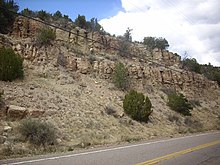Atrasado Formation
The Atrasado Formation is a geologic formation in New Mexico. Its fossil assemblage dates the formation to the Kasimovian age of the Pennsylvanian.
| Atrasado Formation Stratigraphic range: Kasimovian | |
|---|---|
 Atrasado Formation north of Jemez Springs, New Mexico | |
| Type | Formation |
| Unit of | Madera Group |
| Sub-units | See text |
| Underlies | Bursum Formation |
| Overlies | Gray Mesa Formation |
| Thickness | 272 m (892 ft) |
| Lithology | |
| Primary | Limestone |
| Other | Sandstone, shale |
| Location | |
| Coordinates | 34.699114°N 107.119999°W |
| Region | New Mexico |
| Country | United States |
| Type section | |
| Named for | Atrasado Arroyo |
| Named by | Kelley and Wood |
| Year defined | 1946 |
Description
The formation consists primarily of marine limestone with some sandstone and shale. It is exposed in the Sandia Mountains,[1] the Lucero Uplift (34.621°N 107.299°W),[2], the western Jemez Mountains,[3], and in the Manzano Mountains.[1]
The formation has been mapped as the Wild Cow Formation in the Manzano Mountains[4] and as the Guadelupe Box Formation in the Jemez Mountains.[5] However, Lucas et al. have recommended abandoning the name Wild Cow Formation and using Atrasado Formation throughout the Madera Group.[1] The formation is likely correlative with the Alamitos Formation in the Sangre de Cristo Mountains.[3]
The formation is underlain by the Gray Mesa Formation, with its base defined by a sandstone interval atop an eroded limestone surface of the Gray Mesa Formation. It is overlain by the Bursum Formation or by the Abo Formation where the Bursum Formation is not present.[3]
The formation is divided into eight members. In ascending stratigraphic order, these are the Bartolo Member, which is 66 meters (217 feet) of slope-forming shale with thin sandstone, limestone and conglomerate beds; the Amado Member, which is 9 meters (30 feet) of bedded, cherty limestone; the Tinajas Member, which is 115 meters (377 feet) of shale with interbedded limestone and sandstone; the Council Spring Member which is 23 meters (75 feet) of mostly algal limestone without chert; the Burrego Member, which is 26 meters (85 feet) of arkosic red beds and limestone; the Story Member, which is 6 meters (20 feet) of limestone; the Del Cuerto Member, which is 16 meters (52 feet) of arkosic red beds and limestone; and the Moya Member, which is 11 meters (36 feet) of bedded limestone and shale.[1]
Fossils
The exposures near Jemez Springs include some of the richest brachiopod fossil beds in North America. Crinoid stems and bryozoans are also part of the fossil assemblage. The Amado Member is particularly rich in brachiopods in the Manzano Mountains.[1]
History of investigation
The unit was first described as the Atrasado Member of the Madera Formation by Kelley and Wood in 1951.[6]
The Pennsylvanian stratigraphy of New Mexico has historically been unusually complex and inconsistent, with dozens of names for groups, formations, and members.[7][1] Kues and Giles recommended that the name Madera Group be applied to similar exposures of shelf and marginal basin beds of Desmoinean (upper Moscovian) to early Virgilian age found from north-central and central New Mexico south along the west side of the Orogrande Basin as far as the Caballo and Robledo Mountains.[8] Lucas et al. recommended abandoning the name Wild Cow Formation and using Atrasado Formation throughout the Madera Group.[1]
Footnotes
- Lucas et al. 2016
- Kelley and Wood 1946
- Kues and Giles 2004, pp.98-100
- Myers 1973
- Krainer et al. 2005
- Kelley and Wood 1951
- Kues and Giles 2004, p. 100
- Kues and Giles 2004, p. 101
References
- Kelley, V.C.; Wood, G.H.,Jr. (1946). "Geology of the Lucero uplift, Valencia, Socorro, and Bernalillo Counties, New Mexico". U.S. Geological Survey Oil and Gas Investigations. Preliminary Map OM-47. Retrieved 22 May 2019.
- Krainer, Karl; Vachard, Daniel; Lucas, Spencer G. (2005). "Lithostratigraphy and biostratigraphy of the Pennsylvanian-Permian transition in the Jemez Mountains, north-central New Mexico". In Lucas, S.G.; Zeigler, K.E.; Spielman, J.A. (eds.). The Permian of Central New Mexico. 31. New Mexico Museum of Natural History and Science Bulletin.
- Kues B.S. Giles K.A., 2004, The late Paleozoic Ancestral Rocky Mountain system in New Mexico, in Mack G.H. Giles K.A., eds., The geology of New Mexico. A geologic history: New Mexico Geological Society Special Volume 11, p. 95–136.
- Lucas, Spencer G.; Krainer, Karl; Vachard, Daniel (2016). "The Pennsylvanian section at Priest Canyon, southern Manzano Mountains, New Mexico" (PDF). New Mexico Geological Society Field Conference Series. 67. Retrieved 11 June 2020.
- Myers, D.A. (1973). "The Upper Paleozoic Madera Group in the Manzano Mountains, New Mexico". Contributions to Stratigraphy. Bulletin 1372-F.